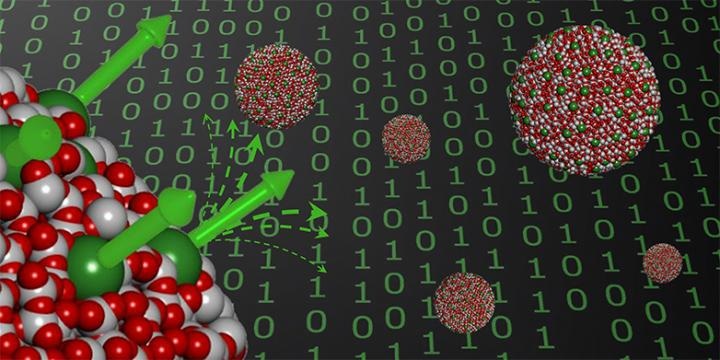Mar 31 2017
 Dysprosium atoms (green) on the surface of nanoparticles can be magnetized in only one of two possible directions: "spin up" or "spin down." (Credit - ETH Zurich / Universite de Rennes)
Dysprosium atoms (green) on the surface of nanoparticles can be magnetized in only one of two possible directions: "spin up" or "spin down." (Credit - ETH Zurich / Universite de Rennes)
If only one atom or small molecule was necessary for a single unit of data (a zero or a one as in binary digital technology), enormous volumes of data could be stored in the smallest amount of space.
Certainly an intriguing idea, which is theoretically possible, as some atoms can be magnetized in just one of two possible directions: “spin up” or “spin down”. Then the information could be stored and read according to the sequence of the molecules’ magnetization directions.
However, there are quite a few obstacles that need to be dealt with before single-molecule magnet data storage becomes a read deal. Locating molecules that are capable of storing the magnetic information permanently and not just transitorily is a challenge, and it is a lot harder to arrange these molecules on a solid surface to construct data storage carriers.
To find a solution to the latter problem, an international team of researchers led by chemists from ETH Zurich have currently formulated a new technique that offers several advantages over other methods.
Fusing atoms to the surface
Christophe Copéret, a professor at the Laboratory of Inorganic Chemistry at ETH Zurich, and his team created a molecule having a dysprosium atom at its center. Dysprosium is a metal that falls under the rare-earth elements category. This atom is enclosed by a molecular scaffold that acts as a vehicle.
The researchers also formulated a technique for depositing this type of molecules on the surface of silica nanoparticles and fusing them by annealing at 400 °C. The molecular structure used as a vehicle breaks in the process, producing nanoparticles with dysprosium atoms well-spread at their surface. The researchers demonstrated that these atoms can be magnetized and preserve their magnetic information.
The magnetization process at present only functions at about minus 270 °C (near absolute zero), and the magnetization can be sustained for about one and a half minute. The researchers are searching for techniques that will permit the magnetization to be stabilized at higher temperatures, and to last for extended periods of time. They are also seeking ways to fuse atoms to a flat surface rather than to nanoparticles.
Simple preparation
One of the highlights of the new technique is its simplicity.
Nanoparticles bonded with dysprosium can be made in any chemical laboratory. No cleanroom and complex equipment are required.
Florian Allouche, Doctoral Student, ETH Zurich
Additionally, it is possible to store magnetizable nanoparticles at room temperature and re-utilized.
Other preparation techniques include the direct deposition of separate atoms onto a surface, yet the materials attained are only stable at very low temperatures chiefly because of the agglomeration of these individual atoms.
Alternatively, molecules with suitable magnetic properties can be deposited onto a surface, but this immobilization time and again negatively affects the magnetic properties and the structure of the final object.
ETH scientists collaborated with colleagues from the Universities of Lyon and Rennes, Collège de France in Paris, Paul Scherrer Institute in Switzerland, and Berkeley National Laboratory in the USA for this research project.
Reference
Allouche F et al.: Magnetic Memory from Site Isolated Dy(III) on Silica Materials. ACS Central Science 2017, doi: 10.1021/acscentsci.7b00035